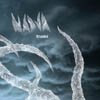 This week’s release from the prolific duo is actually the reissue of a 2006 CDR-only release of live material that truly demonstrates how proficient the band is in a live setting, with a four song set that could easily be mistaken for a tightly constructed studio album, and two additional live pieces that differ somewhat in feel, but are still of the same high quality.
This week’s release from the prolific duo is actually the reissue of a 2006 CDR-only release of live material that truly demonstrates how proficient the band is in a live setting, with a four song set that could easily be mistaken for a tightly constructed studio album, and two additional live pieces that differ somewhat in feel, but are still of the same high quality.
The overall sound and feel of this album shouldn’t surprise any Nadja fans, there are no drastic departures in the formula: slow stripped down drum machine programming, massive walls of low end distortion and carefully controlled washes of guitar noise. To get my personal preference out of the way, I’m still not big on the Nadja overdriven digital distortion sound; I think I’m cursed to keep my preference for a warmer analog sound, but it’s not a detriment at all here because there is so much else going on at any given time.
Most amazing is the fact that this is all entirely within a live setting: the rigid structure and synth-like sustained guitar work on “Breakpoint” sound like it would have been much more of a studio creation than a live one, but that definitely wasn’t the case. Similarly, the slow build from quiet dark ambience to a more forceful sound and finally a blowout of noise and distortion that makes up “Corrasion.”
The band also covers Swans’ “No Cure for the Lonely” during this original performance, which stripped the material down to a duo performing it as opposed to the original’s full lavish band, but the song loses little in the transition, and even awash in the buzzing distortion and bass roar the melodies of the original track shine through. Vocals are even present, though so low in the mix to become essentially inaudible, but still there. It is refreshing to see Baker and Buckareff pick an obscure post-Burning World track such as this as opposed to one of earlier murky sludge material.
The centerpiece of the album is the sprawling 17 minute “Tremble,” which actually appears here in a second version recorded live in Philadelphia. Both versions follow the same blueprint, but the sound and recording settings set them apart. The track opens with carefully controlled feedback, swells of noise that the band manages to reign in and shape, combined with digitally stretched loops. The track continues to build and build in volume and density with guitar drones that sound like an entire orchestra performing until finally reaching a crescendo of pure noise, only to fall apart at the very end into a cacophony of bass and guitar fragments and what could be a dying drum machine. The alternate take recorded by Scott Slimm (of the Archive label) is essentially the same work, but with a reduced level of distortion and noise that allows more of the pure guitar and bass tone to seep through. It follows the same compositional structure and pattern, but the color of the sound is different, and subtler.
The other additional track, “Stays Demons,” also has a slightly more open feeling, driven by heavier bass frequencies, but the multitude of guitar tones that appear sound more like an army of players rather than a single instrument. Again, either the different setting or different approach the band took to this performance allows an entirely different feeling to shine through that, while different than the remainder of the album, is just as well done.
Considering this is a live recording, the diversity and attention to structure and composition are especially notable. Assuming there was a minimal use (if any) of pre-recorded backing tracks, the sheer depth and variety of sound that is produced here is astounding. Coupled with the well developed structure and composition of the tracks, and this makes for some of Nadja’s best work yet.
samples:
Read More

